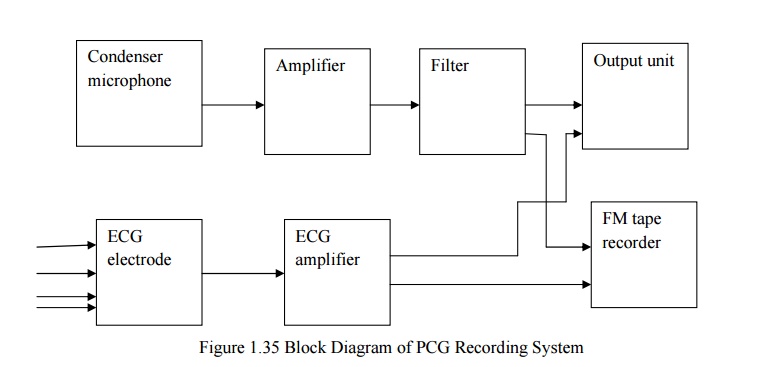Chapter: Medical Electronics : Electro-Physiology and Bio-Potential Recording
PCG (Phono Cardiogram)
PCG (PHONO CARDIOGRAM)
The
graphical record of heart sound is known as Phono Cardiogram. Here Cardio means
the heart. The device which is used to measure heart sound is known as
phonocardiograph. Auscultation: The technique of listening sound produced by
organs and vessels of the body is known as auscultation.
In PCG,
different types of heart sounds are measured. These heart sounds are due to the
vibrations set up in the blood inside the heart by the sudden closure of
valves. In abnormal heart additional sounds are heard between the normal heart
sound. These additional sounds are known as murmurs.Murmers is generally caused
by improper opening of the valves or by regurgitation.
CLASSIFICATION OF HEART SOUND
It is
divided into four types
ü Valve
closure sound
ü Ventricular
filling sound
ü Valve opening
sound
ü Extra
cardiac sound
Valve closure sound
This
sound occurs at the beginning of systole and at the beginning of diastole.
Ventricular filling sound
This
sound is occurred at the time of filling of the ventricles.
Valve opening sound
This sound
occurs at the time of opening of atrio- ventricular valves and semi lunar
valves.
Extra cardiac sound
This
sound occur in mid systole or late systole or early diastole
Systole: The contraction of the heart
muscle. The systolic pressure is 120mm of Hg. Diastole: The relaxation of the heart muscle. The diastolic
pressure is 80 mm of Hg.
1. PCG RECORDING SYSTEM
Microphone
is used to convert heart sound into the electrical signals. Certain positions
are recommended to pick up the heart sound by using microphone. The electrical
signal picked up by the microphone is amplified by the amplifier block. The
amplified output is given to filter block.


Here high
pass filter is used. Its cut of frequency is 1 kHz. Here ECG electrode system and
ECG amplifiers are usedfor reference for PCG. So ECG and PCG outputs are
connected to FM tape recorder and output display unit.
TYPES OF MICROPHONES USED IN PCG
1. Air
coupled microphone- Movement of chest is transferred through the air cushion.
It provides low mechanical impedance to the chest.
2. Contact
microphone – it is directly coupled to the chest wall and provides high
impedance, high sensitivity, and low noise. Its light weight is also one of the
advantageous factor.
The first
heart sound is developed during the opening of aortic valve and during the
closing of mitral valve
PCG waveform
Frequency
of first heart sound consists of 30 to 45 Hz. Second heart sound is usually
higher in pitch than the first. Its frequency range is 50Hz to 70 Hz. Third
heart sound is extremely weak vibrate sound is extremely weak vibration. Its
frequency is below 600 Hz.
Aortic
stenos are murmur occurred when the blood is ejected from the left ventricle
through aortic valve due to resistance to ejection, the pressure in the left
ventricle increased. So turbulent blood flow occur.This turbulent blood
impinging the aortic valve. So intense vibration is produced. It produces loud
murmur.
Mitral regurgitation murmur- In this
murmur, blood flows in backward direction through the mitral valve during systole.
Aortic regurgitation murmur – During diastole, sound is heard. In
diastole blood flows in the backward
direction from aorta to left ventricles when valves are damaged, then this
sound is heard.
Mitral stenosis murmur – This murmur is produced when blood is
passed from left atrium to left
ventricle. This sound is very weak.
Related Topics